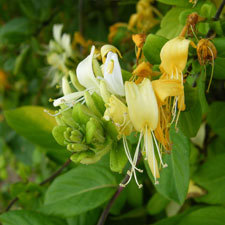 Japanese honeysuckle
Japanese honeysuckle
Common name: Japanese honeysuckle
Botanical name: Lonicera japonica
Management category: Advisory
Originally from Japan. It was introduced to New Zealand as an ornamental species and was recorded as naturalised in 1926. Can grow up to 15m a year in favourable conditions.
Why is it a pest?
- Climbs and smothers most plants from ground cover to medium canopy.
- Can cause canopy collapse and subsequent invasion from grasses and ground vines.
- Provides support for faster growing weedy vines.
Where is it found?
Found throughout the Bay of Plenty region. Japanese honeysuckle can be found in backyards, forest margins, shrublands, disturbed forests, coastal areas, river systems, wetland margins, fernland and inshore islands.
What does it look like?
- A vigorous evergreen climber with long, wiry stems that twine clockwise, are purplish and hairy when young and turn woody and hollow as they mature.
- Leaves are in opposite pairs on the stems and are shiny dark green, though occasionally yellowish, on the top and lighter green below.
- Pairs of two-lipped, sweetly scented tubular white flowers that age to yellow are produced from September to May.
- Flowers are followed by egg-shaped, glossy black berries in colder parts of New Zealand containing seeds.
What are the rules?
Advisory
Council does not enforce the control of advisory species. It is landowner/occupier responsibility to manage these pests. Council may provide advice on how to manage or control advisory species if required.
How do you get rid of it?
- Dig-out (all year) – transfer, bury or burn waste
- Cut and Paste (all year) – Metsulfuron-methyl or Triclopyr + Picloram or Picloram gel.
- Spray (summer to autumn) – Glyphosate or Metsulfuron-methyl or Triclopyr + Picloram.
CAUTION: When using any herbicide or pesticide, PLEASE READ THE LABEL THOROUGHLY to ensure that all instructions and directions for the purchase, use and storage of the product, are followed and adhered to.
Read more on pest control advice, information and regulations.
Images





